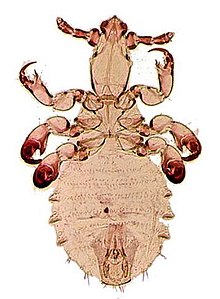
There are 38 subspecies of Canis lupus listed in the taxonomic authority Mammal Species of the World. These subspecies were named over the past 250 years, and since their naming, a number of them have gone extinct. The nominate subspecies is the Eurasian wolf.
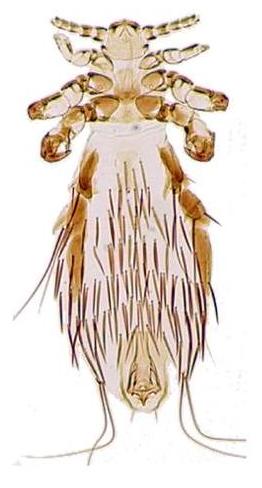
Louse is the common name for any member of the clade Phthiraptera, which contains nearly 5,000 species of wingless parasitic insects. Phthiraptera has variously been recognized as an order, infraorder, or a parvorder, as a result of developments in phylogenetic research.

The genus Haematomyzus includes three species of lice that differ so markedly from all other lice that the genus is placed in its own family Haematomyzidae, itself monotypic within the superfamily Rhynchophthirina. These unusual lice are ectoparasites of elephants and warthogs. Their mouthparts are elongated to form a drill-like structure that allows them to penetrate the thick skin of their host.
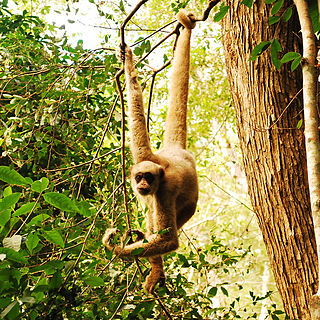
The muriquis, also known as woolly spider monkeys, are the monkeys of the genus Brachyteles. They are closely related to both the spider monkeys and the woolly monkeys. The two species are the southern and northern muriquis. They are the two largest species of New World monkeys, and the northern species is one of the most endangered of all the world's monkeys.
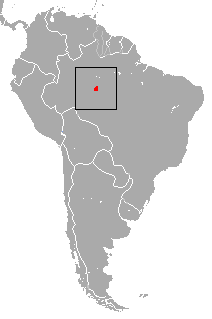
The Roosmalens' dwarf marmoset, also known as the black-crowned dwarf marmoset, is a small New World monkey native to the Amazon Rainforest, on the east bank of the lower Madeira River, and the west bank of the Aripuanã River, in Brazil. It has the smallest distribution of any primate in Amazonia. This marmoset has several unique attributes, which has resulted in it sometimes being placed in the monotypic genus Callibella. However, genetic analysis has subsequently resulted in its being classified within the genus Mico.

Troctomorpha is one of the three major suborders of Psocodea (barklice, booklice, and parasitic lice), alongside Psocomorpha and Trogiomorpha. There are more than 30 families and 5,800 described species in Troctomorpha. The order includes parasitic lice, which are most closely related to the booklice family Liposcelididae.

Pedicinus hamadryas is a species of sucking louse. Its typical host is the baboon .

Fahrenholzia pinnata is a species of louse. Its typical host is a rodent.

Haematopinus is a genus of insects in the superfamily Anoplura, the sucking lice. It is the only genus in the family Haematopinidae, known commonly as the ungulate lice. All known species are of importance in veterinary medicine. These lice are some of the most economically important ectoparasites of domestic animals. Species infest many domesticated and wild large mammals, including cattle, horses, donkeys, swine, water buffalo, African buffalo, antelope, zebra, deer, and camels. The species Haematopinus tuberculatus has great importance in the water buffalo breading, since this louse is specific to buffaloes, being the main ectoparasite of the species, with important sanitary and economic burden. The Haematopinus tuberculatus is suspected to be involved in the transmission of diseases, such as anaplasmosis. The parasites are found infesting buffaloes in greater concentrations around the ears, base of horns, side of the neck, around the scrotum or udder, and especially at the tip of the tail.

Moniliformidae is a family of parasitic spiny-headed worms. It is the only family in the Moniliformida order and contains three genera: Australiformis containing a single species, Moniliformis containing eighteen species and Promoniliformis containing a single species. Genetic analysis have determined that the clade is monophyletic despite being distributed globally. These worms primarily parasitize mammals, including humans in the case of Moniliformis moniliformis, and occasionally birds by attaching themselves into the intestinal wall using their hook-covered proboscis. The intermediate hosts are mostly cockroaches. The distinguishing features of this order among archiacanthocephalans is the presence of a cylindrical proboscis with long rows of hooks with posteriorly directed roots and proboscis retractor muscles that pierce both the posterior and ventral end or just posterior end of the receptacle. Infestation with Monoliformida species can cause moniliformiasis, an intestinal condition characterized as causing lesions, intestinal distension, perforated ulcers, enteritis, gastritis, crypt hypertrophy, goblet cell hyperplasia, and blockages.

Rhadinorhynchidae is a family of parasitic worms from the order Echinorhynchida.
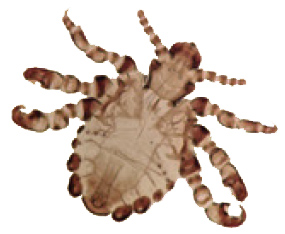
Pthirus gorillae or gorilla louse is a species of parasitic sucking louse that afflicts gorillas. It is found in the African continent, specifically in Rwanda and Democratic Republic of the Congo. P. gorillae and P. pubis are the only known species that belong to the genus Pthirus, often incorrectly spelled as Phthirus. It is suggested that it is transmitted among its hosts by social grooming, shared bedding and sexual contact.
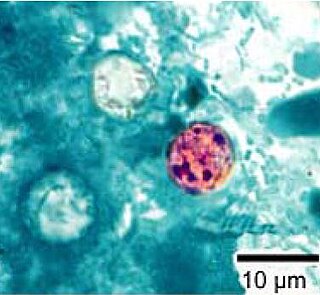
Cyclospora is a genus of apicomplexan parasites. It includes the species Cyclospora cayetanensis, the causative agent of cyclosporiasis. Members of Cyclospora are characterized as having oocysts with two sporocysts, each containing two sporozoites.

Eichler's rule is one of several coevolutionary rules which states that parasites tend to be highly specific to their hosts, and thus it seems reasonable to expect a positive co-variation between the taxonomic richness of hosts and that of their parasites.

Cospeciation is a form of coevolution in which the speciation of one species dictates speciation of another species and is most commonly studied in host-parasite relationships. In the case of a host-parasite relationship, if two hosts of the same species get within close proximity of each other, parasites of the same species from each host are able to move between individuals and mate with the parasites on the other host. However, if a speciation event occurs in the host species, the parasites will no longer be able to "cross over" because the two new host species no longer mate and, if the speciation event is due to a geographic separation, it is very unlikely the two hosts will interact at all with each other. The lack of proximity between the hosts ultimately prevents the populations of parasites from interacting and mating. This can ultimately lead to speciation within the parasite.
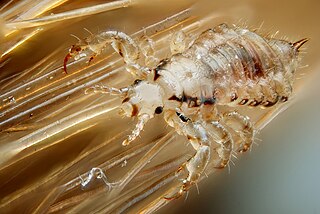
Pediculus is a genus of sucking lice, the sole genus in the family Pediculidae. Pediculus species are ectoparasites of primates.

Colpocephalum is a genus of chewing louse. Christian Ludwig Nitzsch named the genus in 1818. The Plenary Powers of the International Commission on Zoological Nomenclature selected Colpocephalum zebraBurmeister, 1838 as its type species in the 1950s. There are approximately 135 species in this genus, and they are ectoparasites of birds in at least a dozen different orders.

Rallicola is a genus of chewing louse. It is an ectoparasite of rails and other birds. It was named by Thomas Harvey Johnston and Launcelot Harrison in 1911. There are two subgenera aside from the nominotypical subgenus: Aptericola, whose species are found on kiwi birds, and Huiacola, a monospecific subgenus consisting of Rallicola extinctus, once found on the huia.
Enderleinellidae is a family of parasitic lice in the order Psocodea. There are about 5 genera and more than 50 described species in Enderleinellidae.
